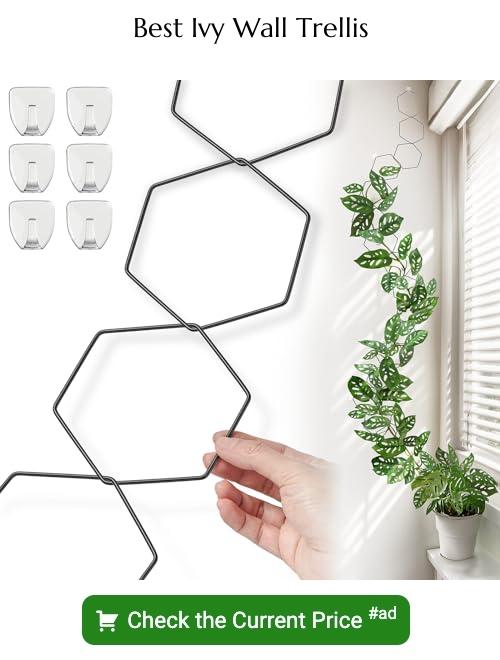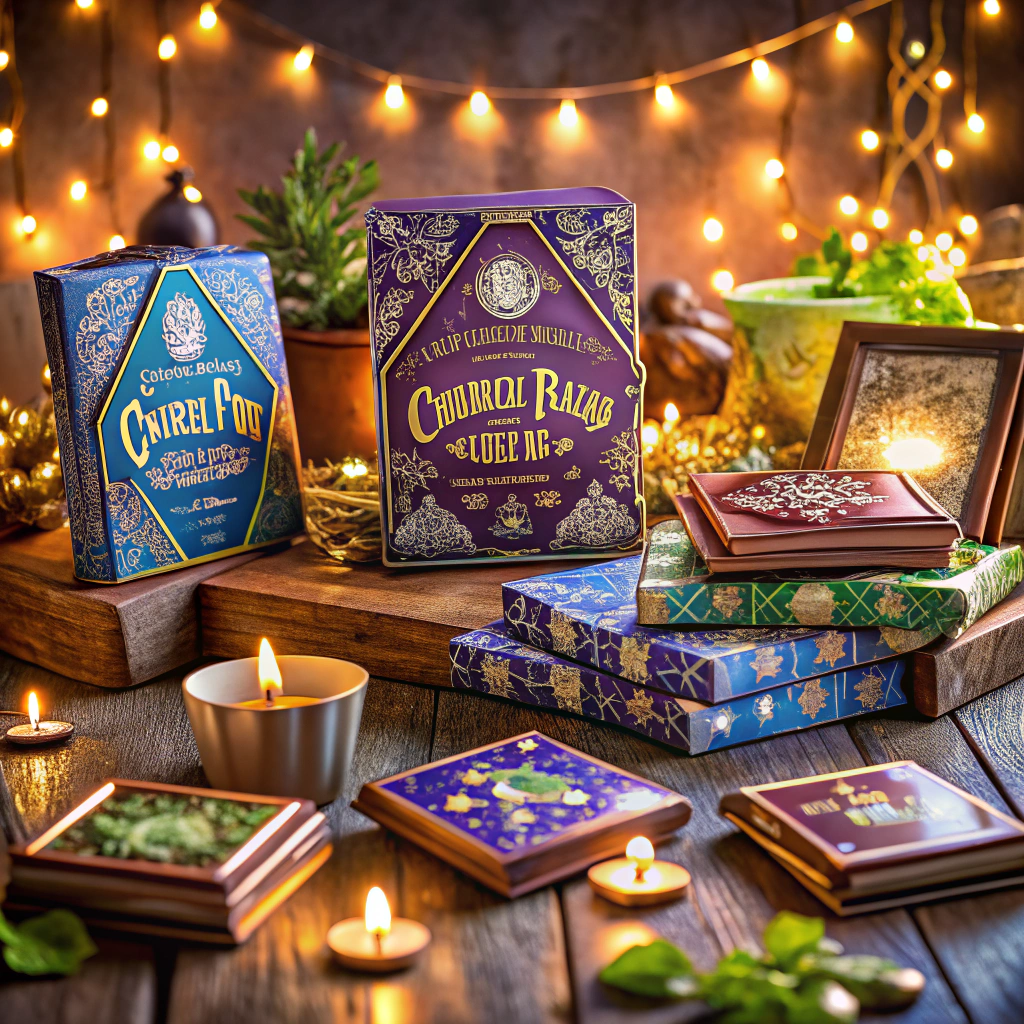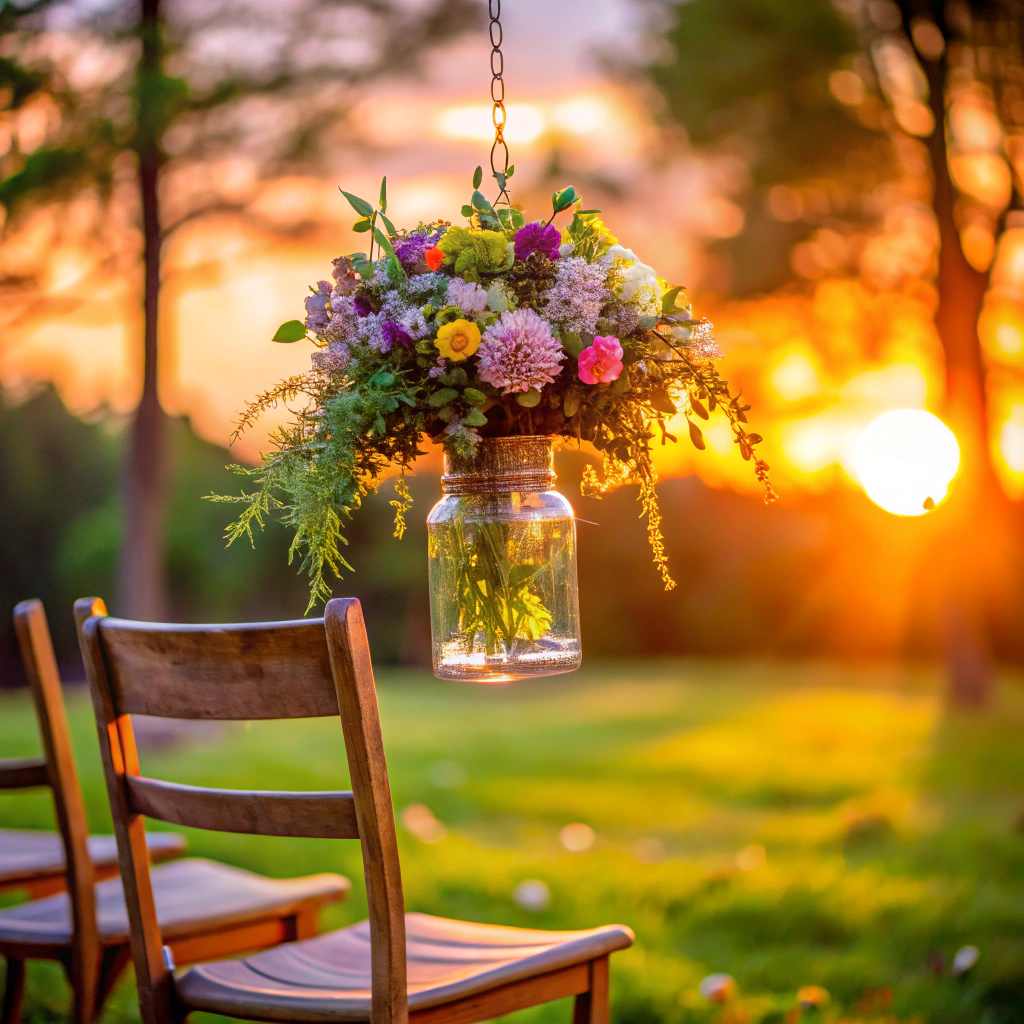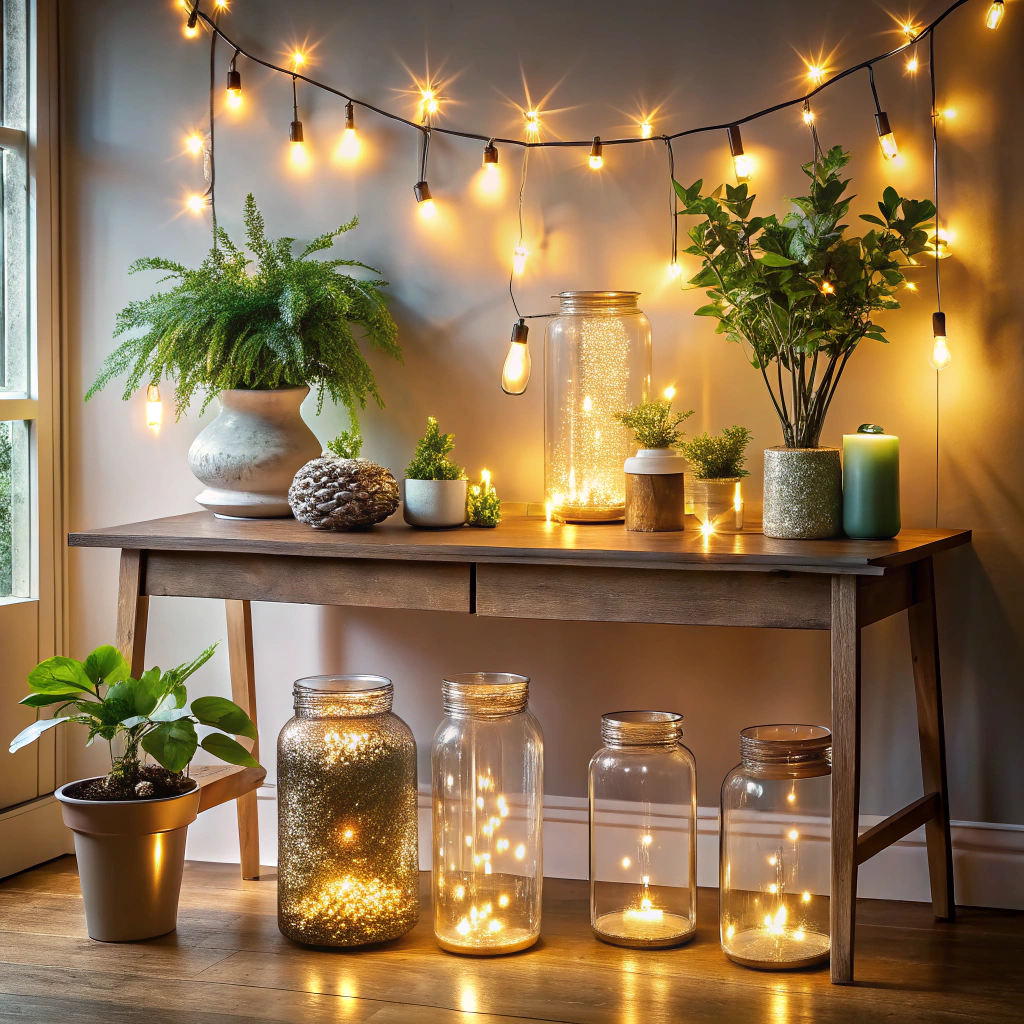Last updated on
Because ivy walls can revolutionize the aesthetic appeal of your home, this article delves into fascinating ivy wall ideas to help spur your creativity.
I’ve designed unique illustrations for these ideas. I hope you get inspired!
Ivy walls can transform your home into a lush, green paradise. Often, this versatile plant gets stereotyped as a mere traditional English cottage-style decor. Yet the realm of ivy wall possibilities is much broader than the internet suggests.
This article is filled with avant-garde ivy wall ideas. Although several tried-and-true concepts are reinforced, the overall tone leans towards viewing ivy in fresh, unexpected ways. Best of the old-world ideas, along with resources, will be touched upon briefly towards the end. However, the primary goal is to explore unique, innovative aspects that give ivy walls a modern twist, making this list useful for those seeking something distinctive.
Simply scroll down to dive into a world of new perspectives on ivy walls.
Lighting Up Your Ivy Wall: Spotlights VS Fairy Lights
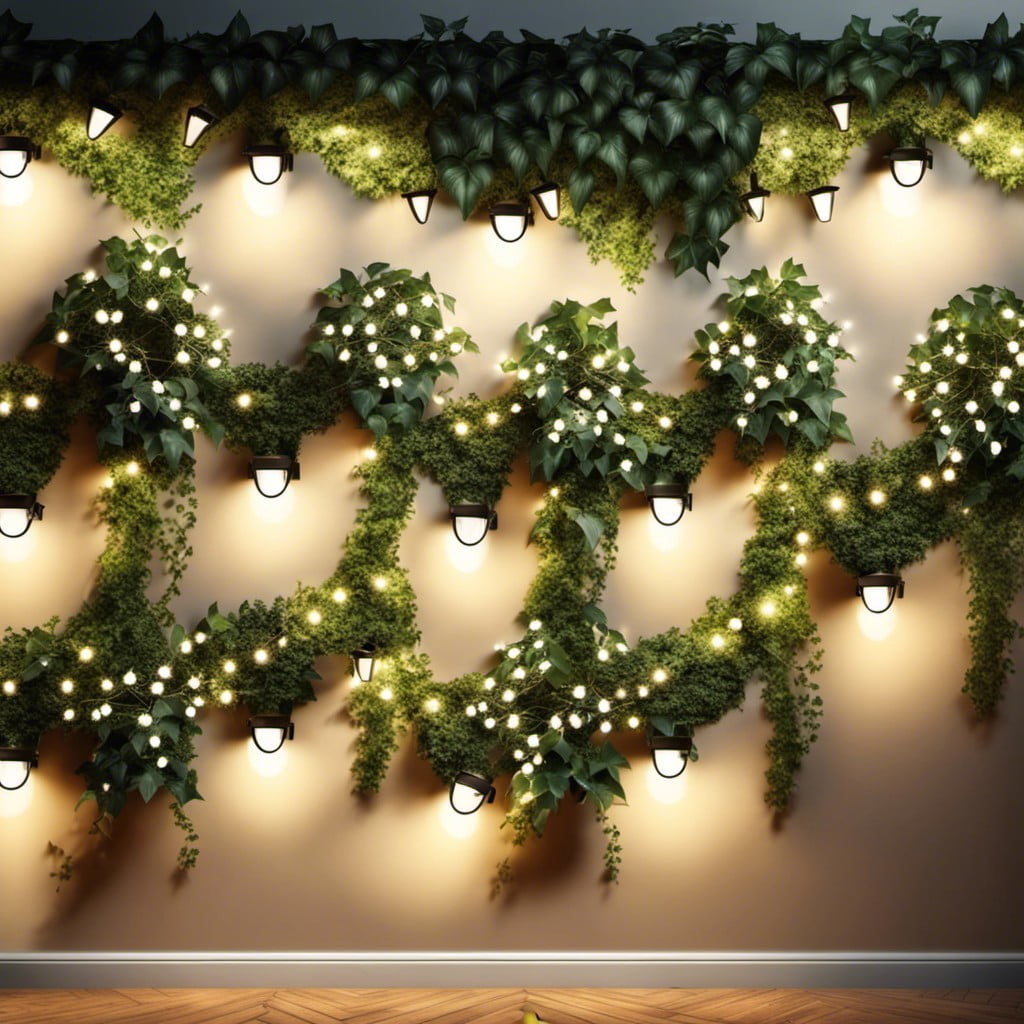
Spotlights, frequently used in landscape lighting, can dramatically highlight the texture and color of the ivy, making it a captivating focal point during night-time. These lights should be positioned strategically on the ground or on another structure, angling the beam towards the ivy wall. LED spotlights are energy-efficient and provide brilliant illumination, ideal for larger ivy walls.
On the other hand, fairy lights present a softer, whimsical ambiance. They are typically wrapped around the vines or weaved through the ivy wall. They come in variety of hues and styles, providing the flexibility to curate the desired mood. Solar-powered fairy lights are an excellent choice for outdoor setups as they charge up during the day and automatically turn on at dusk for a magical display.
It is noteworthy to consider that both lighting options can be utilized simultaneously to generate a layered lighting effect.
Creative Ivy Wall Patterns to Try
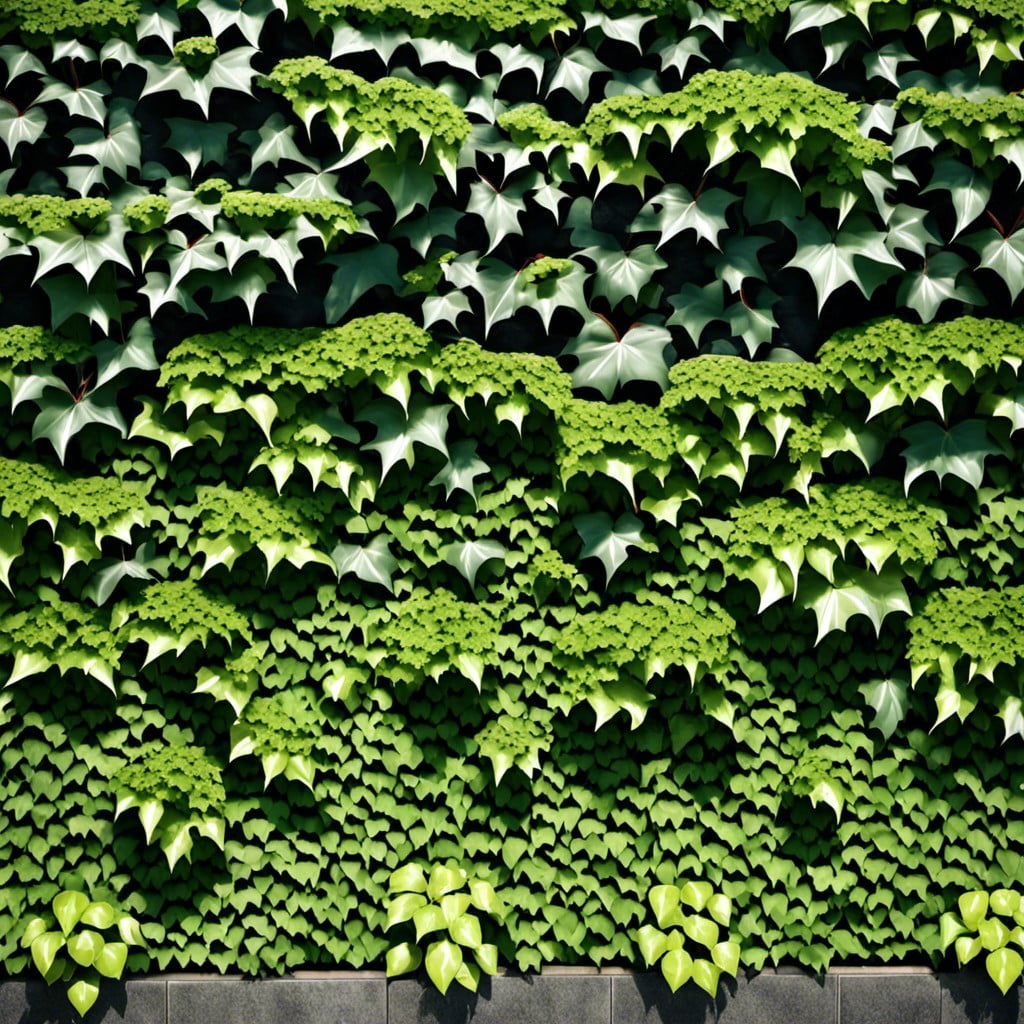
Experimenting with different patterns can truly elevate the aesthetics of ivy walls. Here are a few ideas:
1. The Lattice Layout: This timeless classic involves intertwining the ivy to create a criss-cross pattern. It adds a blanketed, green look to walls.
2. Checkerboard Design: Mix it up by placing ivy in alternating squares. It adds both depth and intrigue to your wall.
3. Vertical Strands: Letting the ivy vines grow in vertical strands creates an interesting waterfall effect. One can create numerous strands and space them evenly for symmetry.
4. Spiral Pattern: For a touch of whimsy, train the ivy to grow in spiral patterns. It takes a bit more work, but the result is breathtaking.
5. Wavy Lines: Let your ivy vines form wavy lines across the wall for an effortless yet captivating design.
Remember, the key to a successful ivy wall is patience and regular maintenance. Happy decorating!
Best Plant Species for a Real Ivy Wall
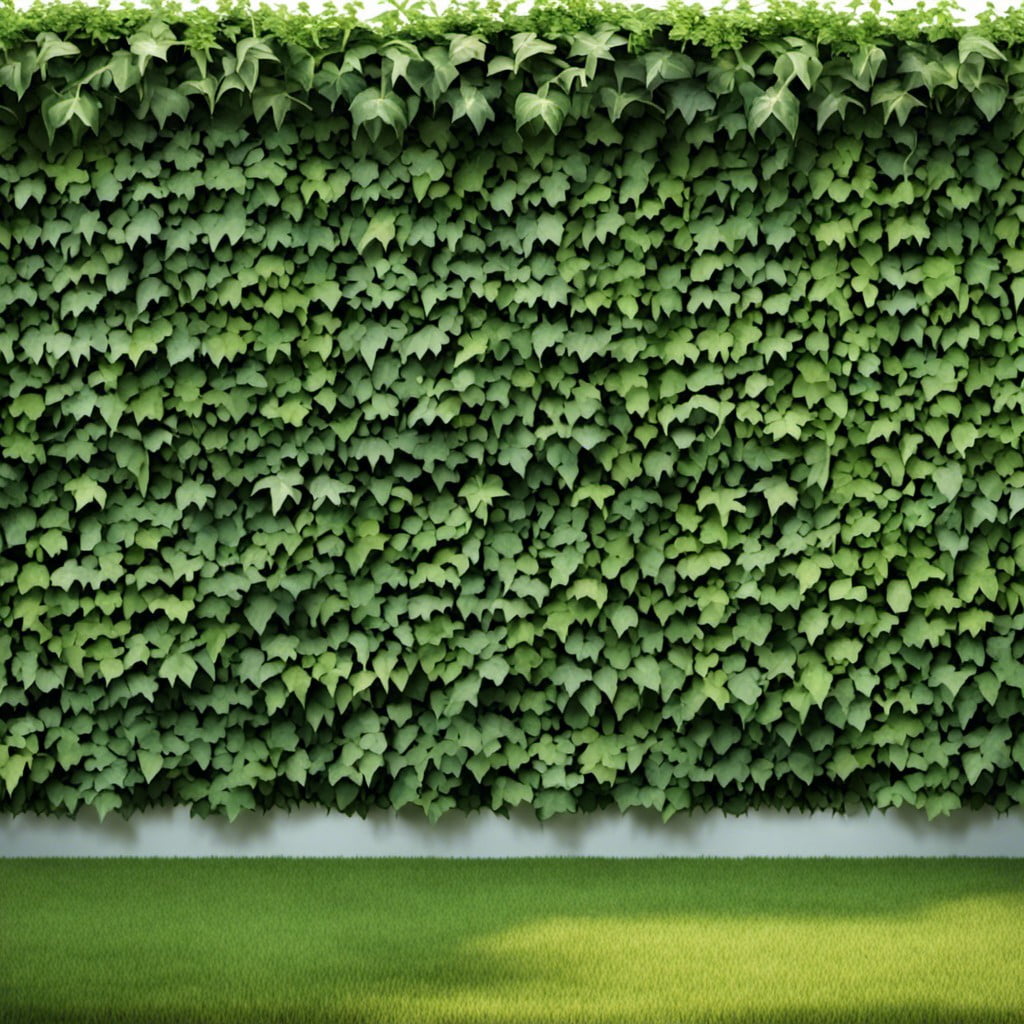
English ivy (Hedera helix) is a common choice due to its hardiness and rich, green color. It adapts well to various conditions and covers surfaces quickly with its decorative leaves.
The Boston ivy (Parthenocissus tricuspidata), not a true ivy, is a fast-growing vine that turns a captivating red color in the fall, adding seasonal charm to your ivy wall.
Persian ivy (Hedera colchica), with its heart-shaped leaves, is a great option for adding unique texture to your green wall. While it requires a bit more care, it can easily become a centerpiece.
Keep in mind, although certain ivy species may be commonly used, it is vital to research what will work best in your specific environment, taking light, moisture, and temperature requirements into consideration. Not all species will be the right fit dependent on your local climate and indoor conditions.
Incorporating Ivy Walls in Small Spaces
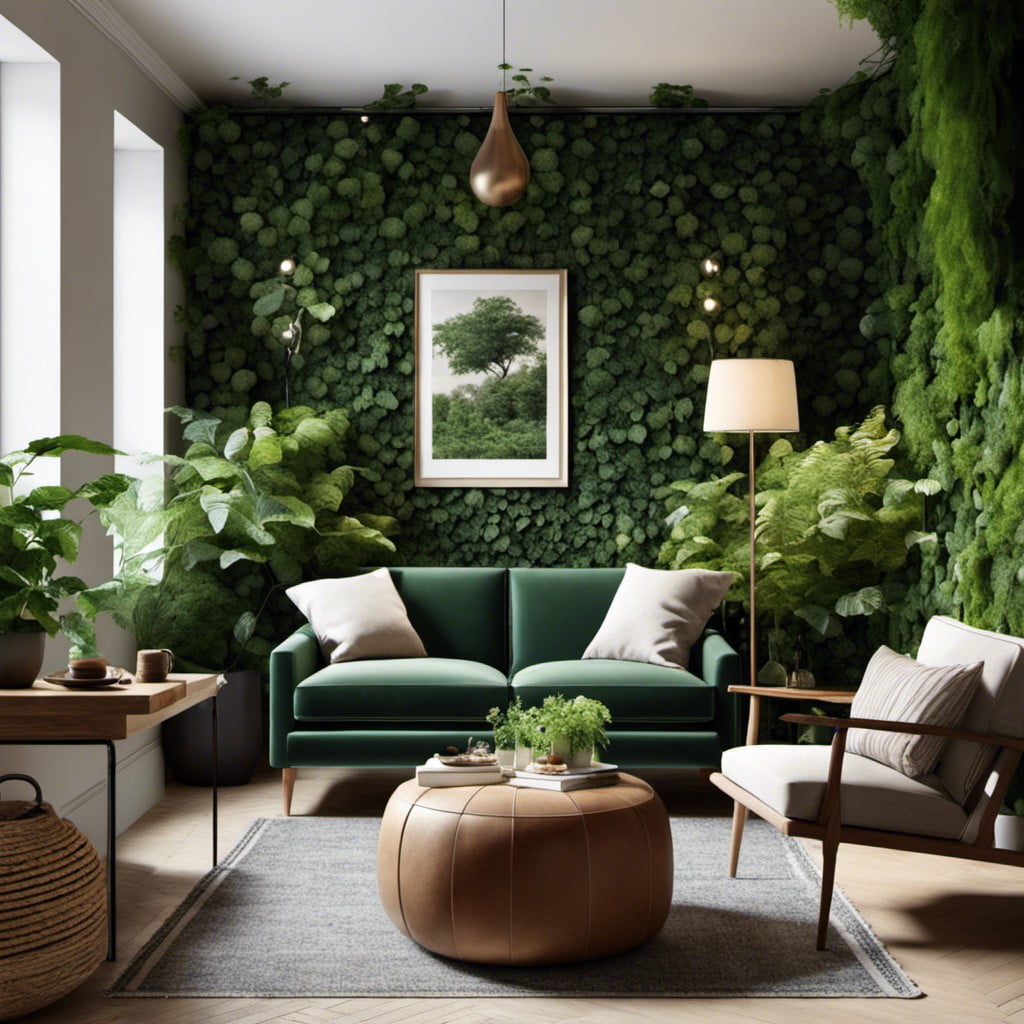
Even in limited square footage, ivy walls can be incorporated effectively. Here’s how:
1. Verticality: Opt for climbing ivies that can grow upwards and make the most of your available space.
2. Half-wall Ivy: Rather than a full wall, consider a half-wall ivy installation. It offers the beauty of an ivy wall without overwhelming a small room.
3. Framing: Use ivy as a living frame around windows or artwork. This can increase visual interest without taking up much room.
4. Containers: Utilize space-saving containers for your ivy. Hanging planters or wall-mounted pots make an excellent choice.
5. Mirrors: Placing mirrors behind your ivy can make the space seem larger, while reflecting the beauty of the plant.
Remember, ivy appears lush and can give a small room a sense of abundance. Nonetheless, be sure to control the growth to avoid a cluttered look.
Outdoor Ivy Walls: A Simple Guide
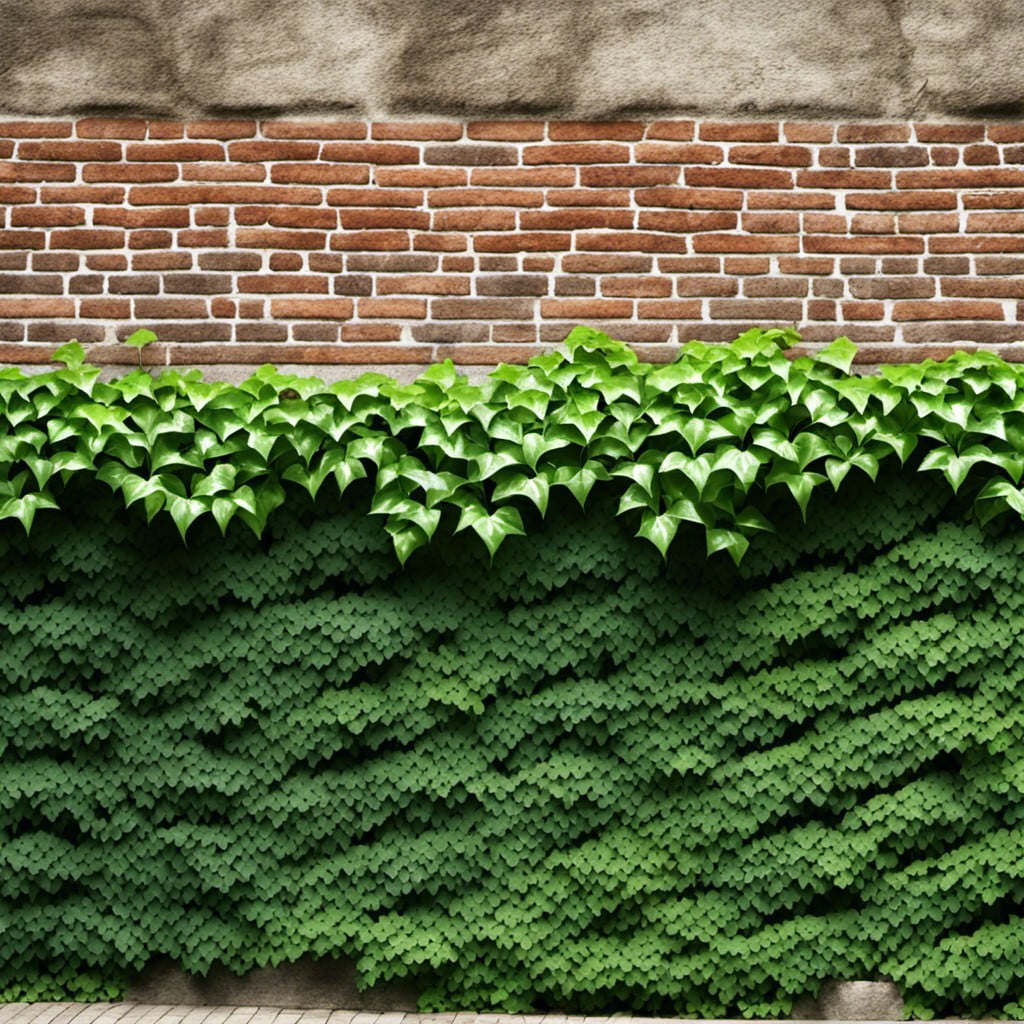
To embark on your outdoor ivy wall project, begin by choosing a suitable location. A wall with partial sun exposure is ideal. While ivy is hardy and adaptable, too much sun might result in scorched leaves. Another important aspect is to ensure that the wall surface is conducive for the creeper to latch on. Rough-textured spots such as brick or stone make the best surfaces.
Secondly, select the appropriate ivy variety. Boston ivy and English ivy are common choices for outdoor spaces due to their rapid growth and hardiness.
Start planting at the base of the wall, evenly spacing your plants. Train the young vines towards the wall, attaching them loosely with garden string or twine to guide their climb.
To maintain your ivy wall, prune regularly to shape and control the plant’s spread. Prepare to tackle common pests such as aphids, spider mites, and powdery mildew. Use only organic treatment methods to manage these problems while maintaining eco-friendly gardening practices.
Remember to check local regulations and consider your neighbors when planning an ivy wall. In some areas, particular species are considered invasive and might risk you running foul of local environmental laws.
Maintenance Tips for Ivy Walls
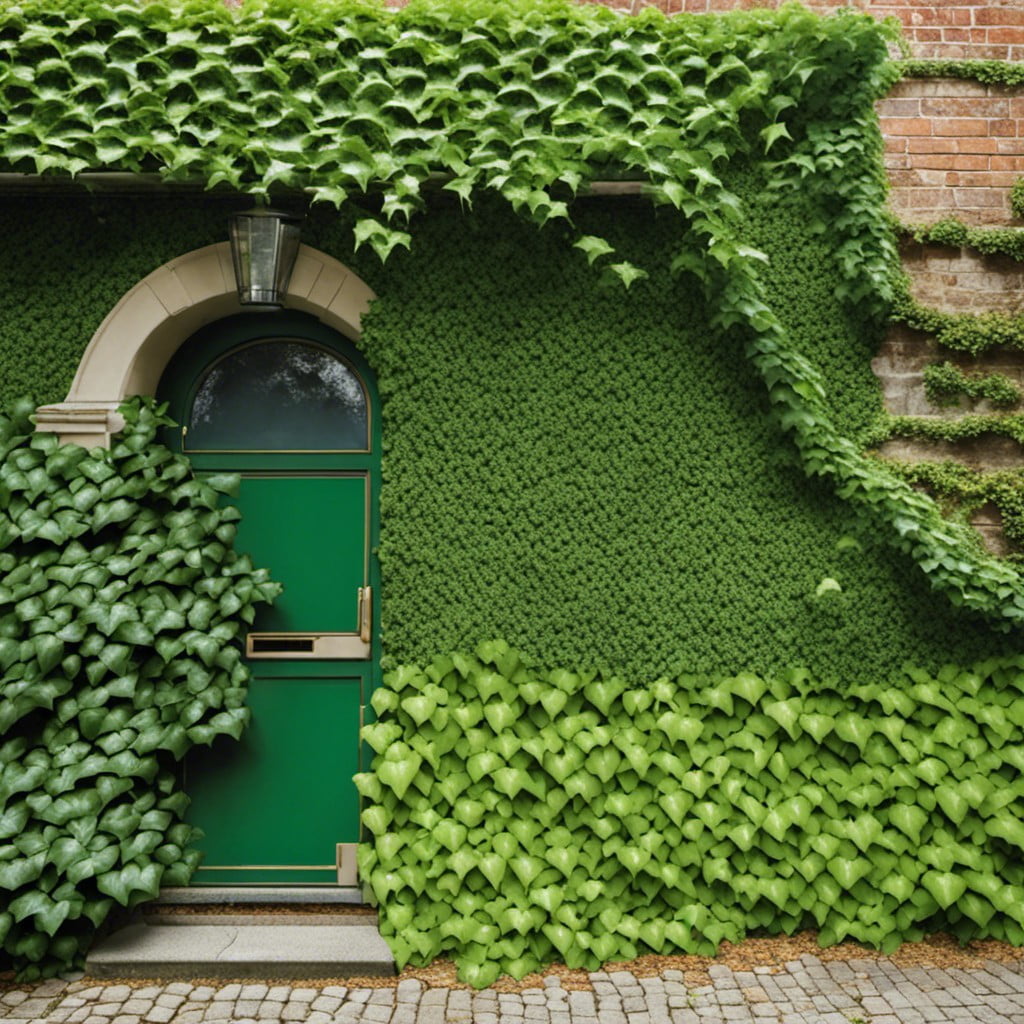
To ensure your ivy wall remains healthy and vibrant, proper care is essential.
Firstly, regular pruning is a must. This includes removing dead leaves as well as trimming back the overall growth to prevent it from getting out of control.
Watering is equally crucial. Keep in mind, however, that ivy doesn’t require as much watering in colder months as it does in the warmer seasons. It’s also important to let the soil dry out completely between waterings to avoid root rot.
Keep an eye on pests, such as aphids and slugs. If your ivy is kept indoors, you should also look out for spider mites. Use organic pest sprays or introduce natural predators like ladybugs.
Lastly, while ivy does not need fertilizing very often, providing it with a balanced fertilizer during the growing season can bolster its health and growth. Remember, too much fertilizer can burn the roots, so tread lightly.
Follow these steps, and your ivy wall can stay as elegant as the day it was first put up.
Ivy Wall Dangers: What You Should Know
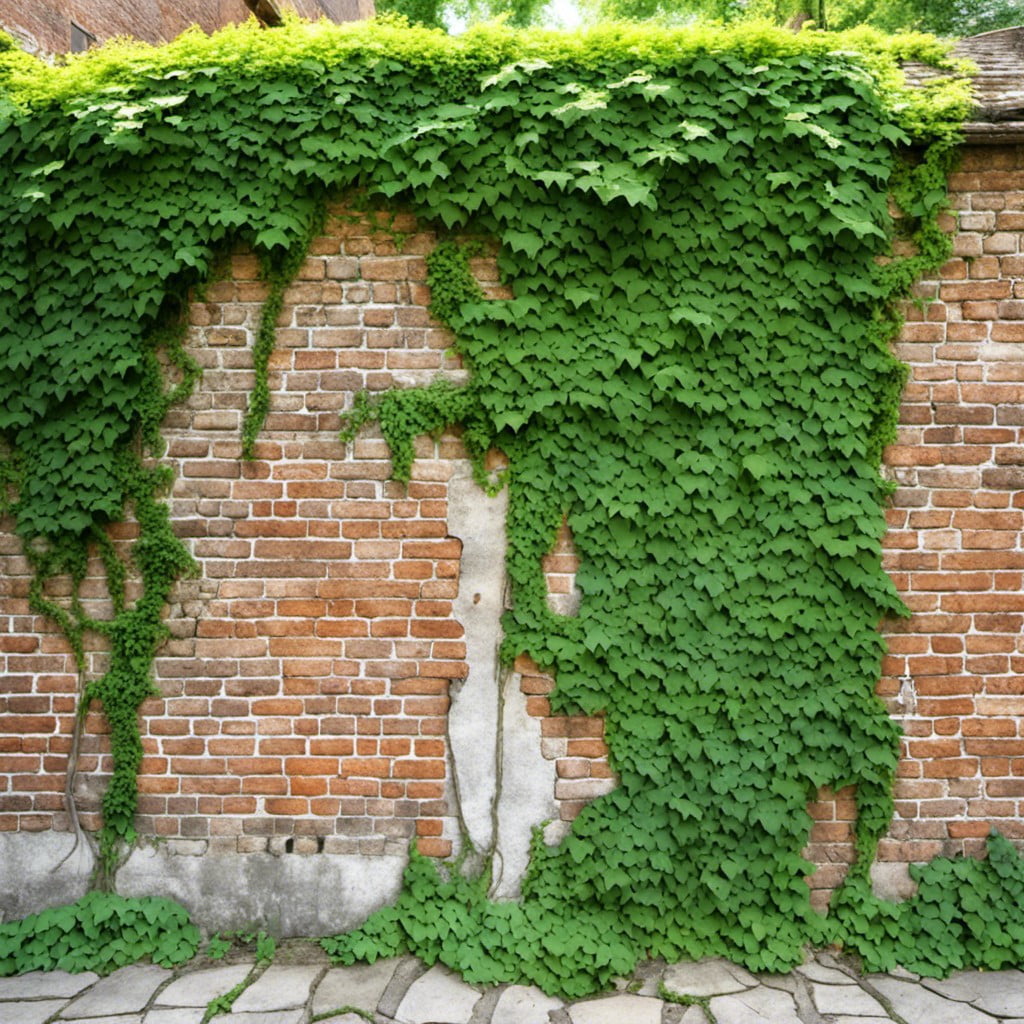
While an ivy wall can make any space feel like a verdant paradise, it’s crucial to understand some potential hazards.
First and foremost, certain types of ivy, such as poison ivy, pose an immediate health risk due to their toxic oils that cause rashes and irritation. It’s critical to recognize these species before they get comfortable around your walls.
Even harmless ivies can penetrate the building’s exterior if not properly curtailed. In time, this invasion may compromise the structure’s integrity, particularly in older buildings where walls and brickwork may already be fragile.
Additionally, ivies can provide a hospitable environment for some not-so-friendly critters, including insects, rodents, or pests. Regular maintenance and professional inspections should keep this risk at bay.
Humidity is another concern. Ivy on indoor walls may increase moisture levels, leading to possible mold growth if not adequately ventilated—a potential health issue to consider.
Lastly, ivy may mask issues on the wall surface beneath—cracks, rotting wood, or brickwork disintegration—that could escalate if unseen or unattended. Regular checks behind the greenery will help ensure the wall’s health.
Despite these points, don’t be deterred. With careful control, the right species, and regular maintenance, an ivy wall can be a safe and fantastic asset to your space.
Sustainable Alternatives to Synthetic Vines
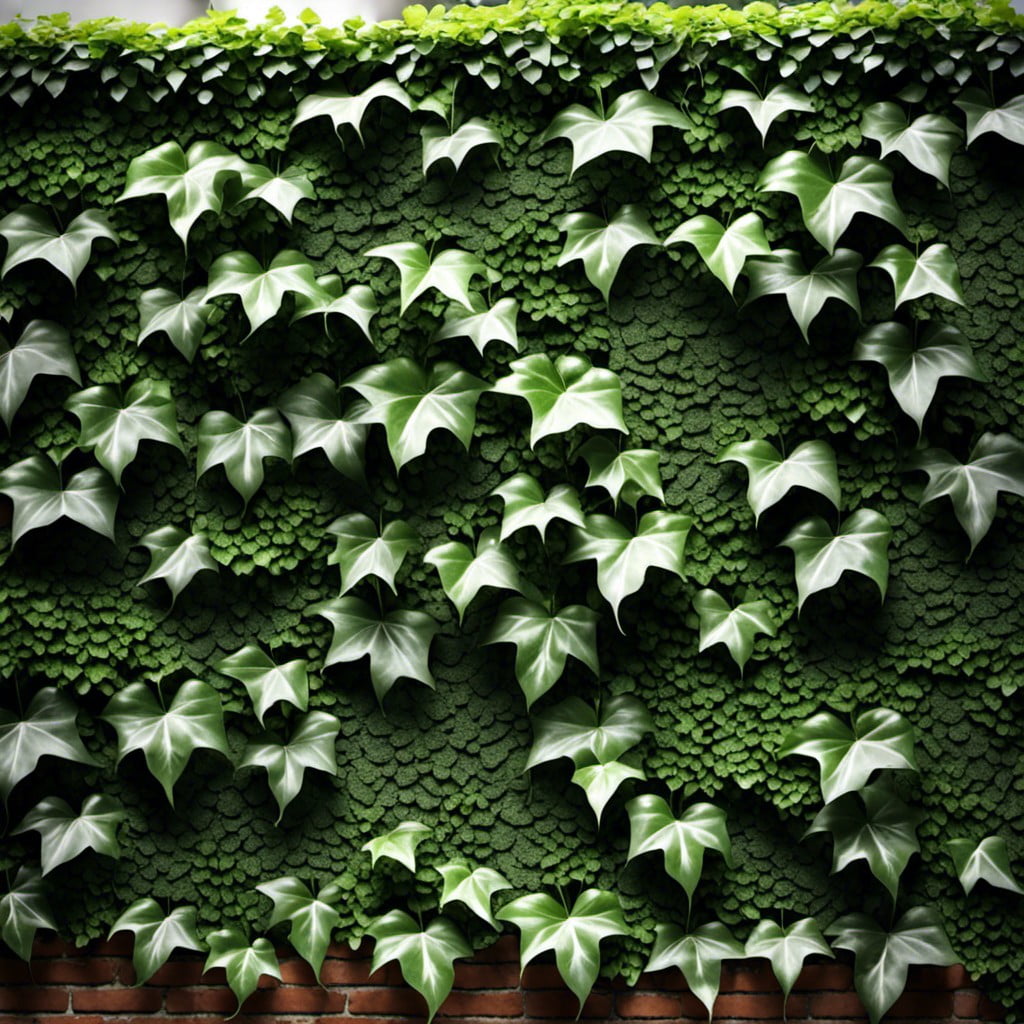
Opting for natural, eco-friendly substitutes to artificial vines provides benefits for both the environment and your home aesthetics. Here are some considerations:
1. Utilize Live Vines: English ivy, Virginia creeper, or Boston ferns are excellent options. These naturally climbing species can recreate the ivy wall effect while providing freshness and authentic greenery. However, they need more care and appropriate lighting conditions.
2. Go with Moss Walls: If maintenance of live vines seems daunting, consider moss walls. They’re sustainable, visually eye-catching, and require minimal watering.
3. Use Sustainable Materials: Seek out artificial vines made from biodegradable materials like natural fibers, silk, or even recycled plastic. These alternatives are more ecologically responsible compared to non-recyclable synthetic options.
4. Plant Ladder Shelves: In lieu of a conventional ivy wall, explore the concept of ladder shelves displaying a variety of plants. This design adds a vibrant green element to your space and affords the flexibility to change plant types when desired.
5. Experiment with Green Paint: Clever use of color and paint techniques can mimic the look of an ivy wall. This solution is not only long-lasting but also sustainable, especially when using non-toxic, eco-friendly paints.
Seasonal Themes For Your Ivy Wall

To keep your living decor fresh and inviting, seasonally adapting the appearance of your ivy wall makes an impressive statement. Here are some captivating ideas to consider:
1. Spring: Complement the awakening of nature by adding spring blooms, such as tulips or daffodils, to your ivy display. Pastel-colored ribbons tied around some ivy vines could also create a softer touch.
2. Summer: Opt for a vibrant, tropical feel by intertwining faux hibiscus or sunflower garlands. Alternatively, hang small decorative lanterns to resemble fireflies on a summer evening.
3. Autumn: Accentuate the mood with faux autumn leaves in varying shades of red, orange, and yellow intertwined with your vines. Miniature pumpkins hung sporadically can also enhance the festive autumn atmosphere.
4. Winter: An icy aesthetic can be achieved with twinkling fairy lights and delicate, silvery baubles. For a more festive look, traditional holiday ornaments such as red ribbons, gold bells, or even small, wrapped gift boxes could be attached.
Remember, you can always experiment freely, these are simply suggestions to inspire you on your journey to the perfect ivy wall aesthetic.
Quirky Accessories to Dress Up an Ivy Wall
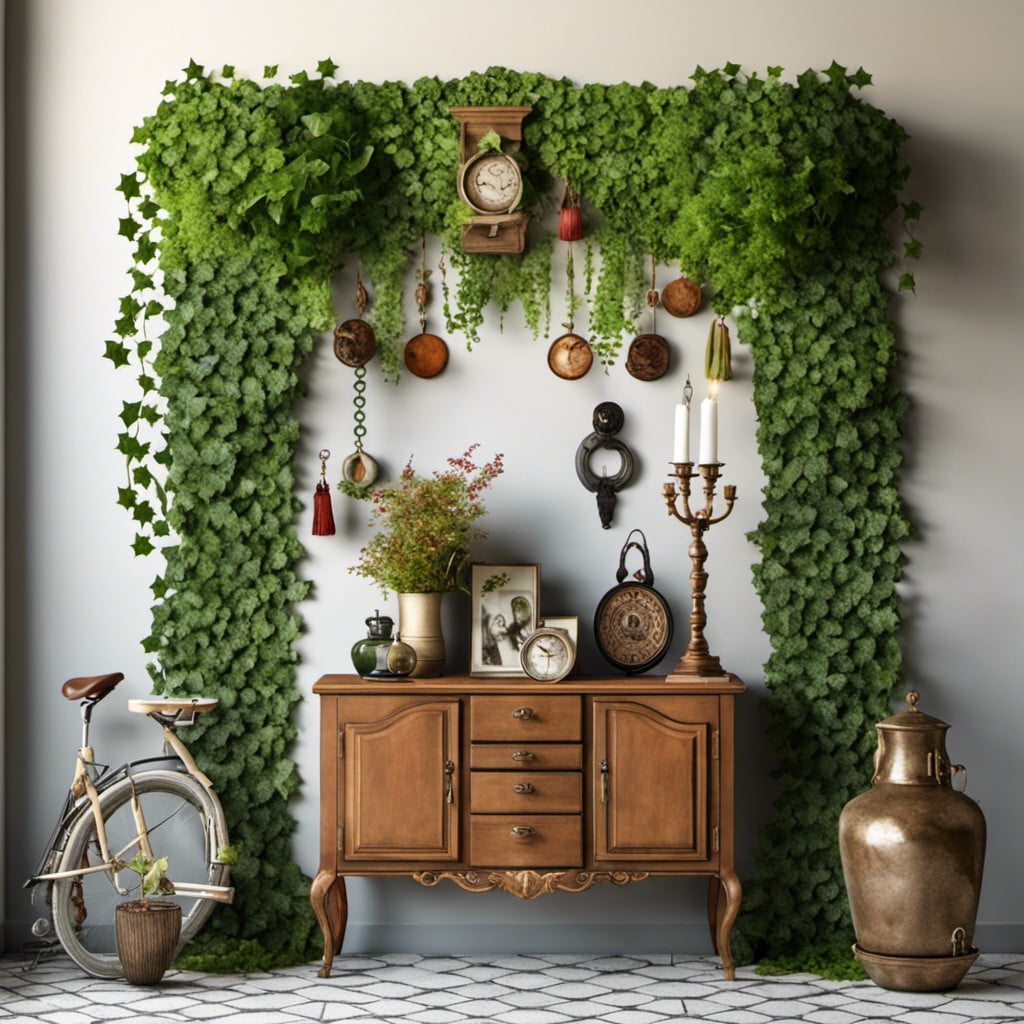
Accentuating the beauty of an ivy wall can be as simple as incorporating unique accessories. For an unexpected touch of whimsy, consider hanging small pieces of art on your ivy wall. Use weather-resistant materials if the ivy wall is outdoors.
Upcycling garden materials into décor is another fun idea. Old, colorful birdhouses or fancy plant pots nestled among the ivy can create eclectic focal points. Just be sure they won’t harm the plants.
Metallic items like wind chimes or mirrors reflect light beautifully against the green background. If you are a fan of zen or spiritual decorating styles, religious symbols or oriental style lanterns among the vine leaves can take the feel of your space to another level.
Don’t forget, it’s important to ensure that the accessories are secure to prevent potential damage or accidents. As always, remember to respect the ivy’s natural growth while handling the accessory placements.
Trellis Design Ideas for an Ivy Wall
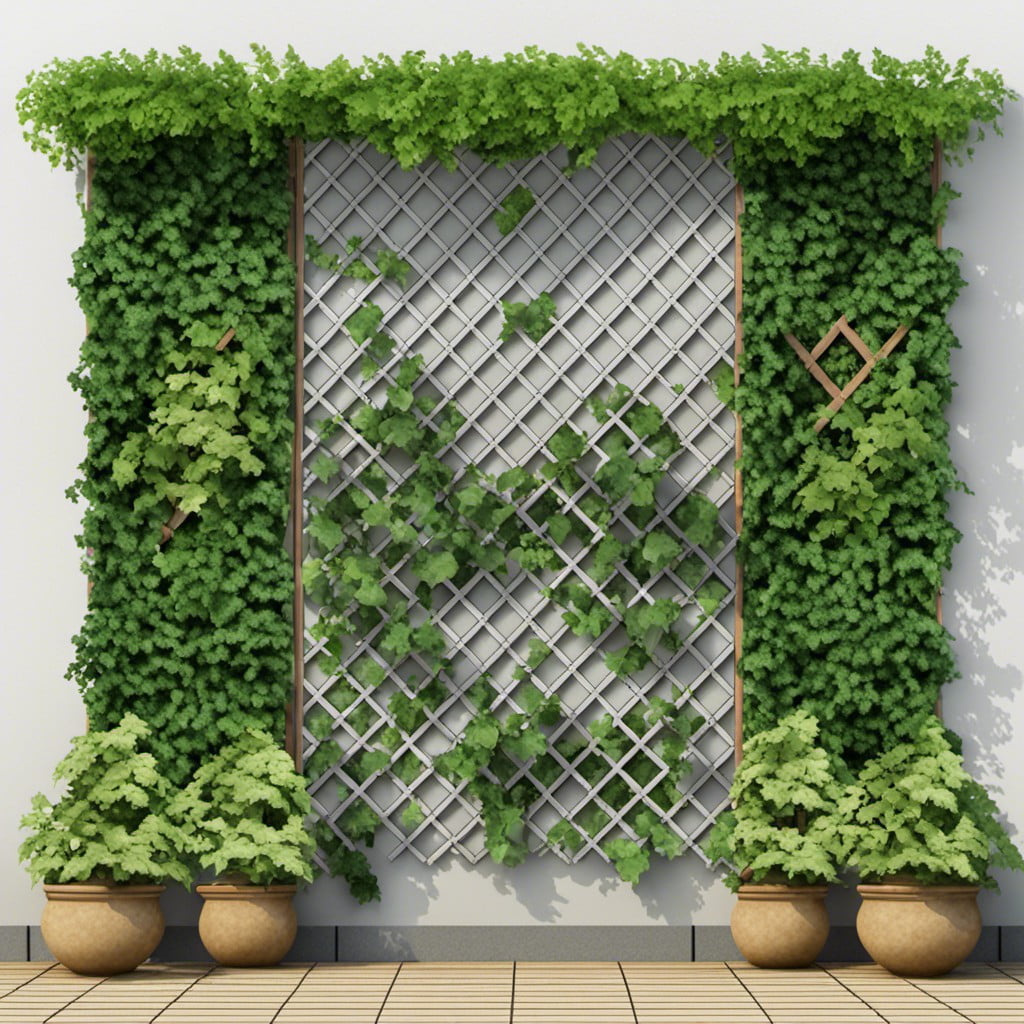
Starting off simply, traditional latticework trellises bring a classic charm to any space while offering excellent support for ivy growth. Known for its flexible use, this design can be incorporated into a variety of home settings.
The fan trellis style provides a delightful twist, starting narrow at the ground and spreading out upwards in a fan-like shape. This design creates visual interest and allows the ivy to frame the outdoor area, perfect for adding a dash of character.
Alternatively, for a more modern touch, consider the ladder trellis design. With its clean lines, it’s suitable for contemporary home architectures. Position it vertically or horizontally, depending on your space and the look you wish to achieve.
An obelisk trellis in a container is an excellent choice for those wanting to introduce an ivy wall indoors. Its sculptural element makes it a fascinating centerpiece around which your ivy can grow. It’s a compact solution for greenery, even in limited spaces such as apartments.
Lastly, the arched trellis forms a stunning ivy-covered entranceway. Bridging two separate garden spaces or leading the way to your front door, an arched trellis offers timeless elegance.
Experimenting with different trellis designs elevates your ivy wall to the next level, making it not just a living piece of art but an architectural feature in your home.
Matching Your Ivy Wall to Your Room Aesthetic
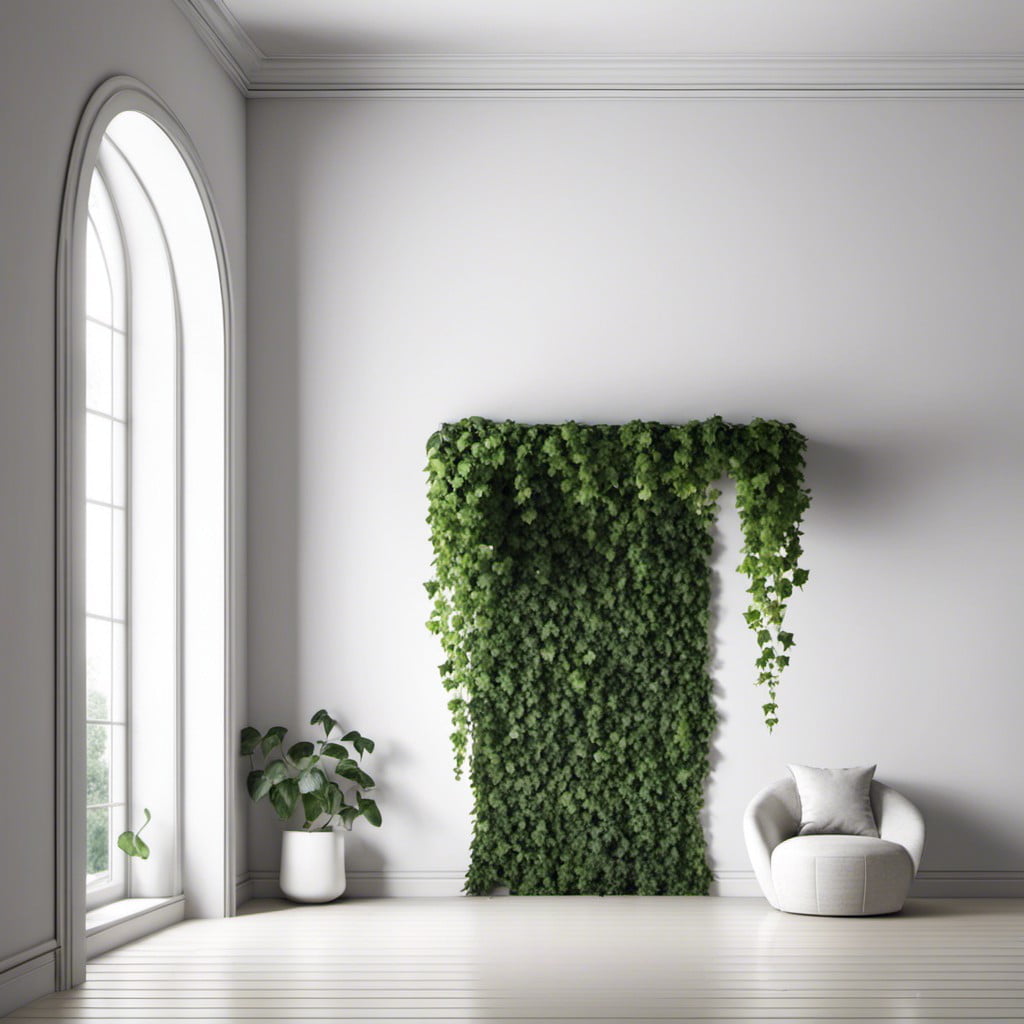
To achieve harmony in your space, consider the pre-existing aesthetic. For modern interiors, aim for structured ivy arrangements with sleek lines. Industrial loft? Allow your ivy to grow freely around vintage metal accents. Those who love Scandi minimalist styles can incorporate ivy with white-painted trellises for a touch of understated greenery.
Don’t forget the color of your ivy leaves. Most are green but variegated varieties can add pops of color like white or gold. Matching these nuances with your room’s color scheme can create a balanced look.
Remember, rugs, cushions, and artwork can draw out the green hues from the ivy wall, so choose textiles and displays that amplify your room’s central theme. If your style is rustic or beach-inspired, combining your ivy wall with natural materials like rattan or distressed wood can also work wonders.
Lastly, for a successful aesthetic match, observe how the room’s light plays across your ivy wall. Light-drenched spaces will highlight your ivy’s lushness, while moody rooms can create striking shadows on the wall. Use this to your advantage for the maximum impact.
Benefits of Ivy Walls for Home and Health
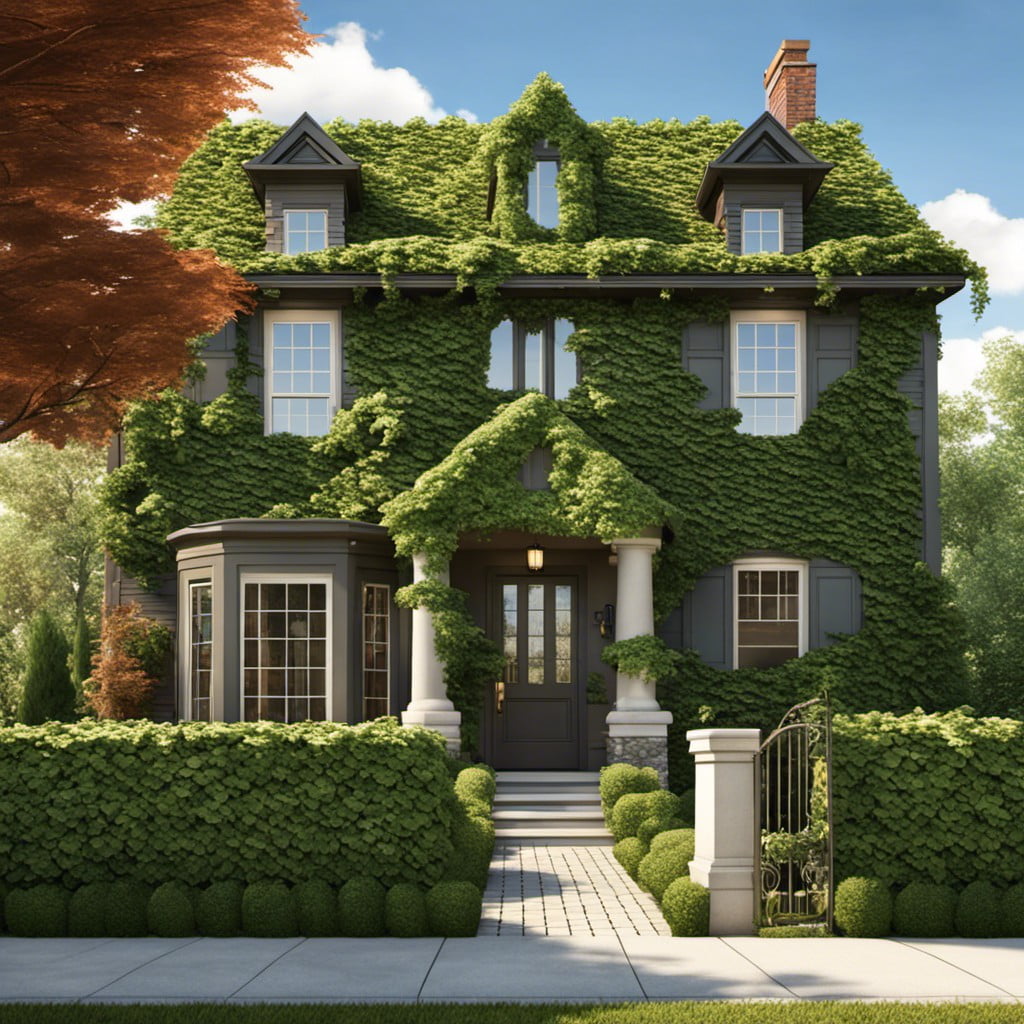
Bringing a piece of nature into your home through ivy walls can contribute surprisingly positive effects. Firstly, these climbing plants act as natural air purifiers, absorbing toxins while producing oxygen, enhancing the air quality of your home environment.
Beyond the physical, ivy walls also lend themselves toward mental wellbeing. Studies highlight that being around greenery can curb stress, bolster mood, and boost concentration levels. This makes ivy walls a great addition to workspaces or areas where focus is necessary.
Lastly, ivy walls provide a unique and dynamic natural insulation which can regulate home temperature all year round. In the summer, the dense leaves shield against heat, keeping the interior cooler. In the winter, the ivy acts as an extra layer of insulation, trapping warmth within the home.
Consider these benefits when planning your ivy wall, achieving not only a visually pleasing addition, but a functional, health-boosting feature as well.
Ivy Wall Mistakes to Avoid
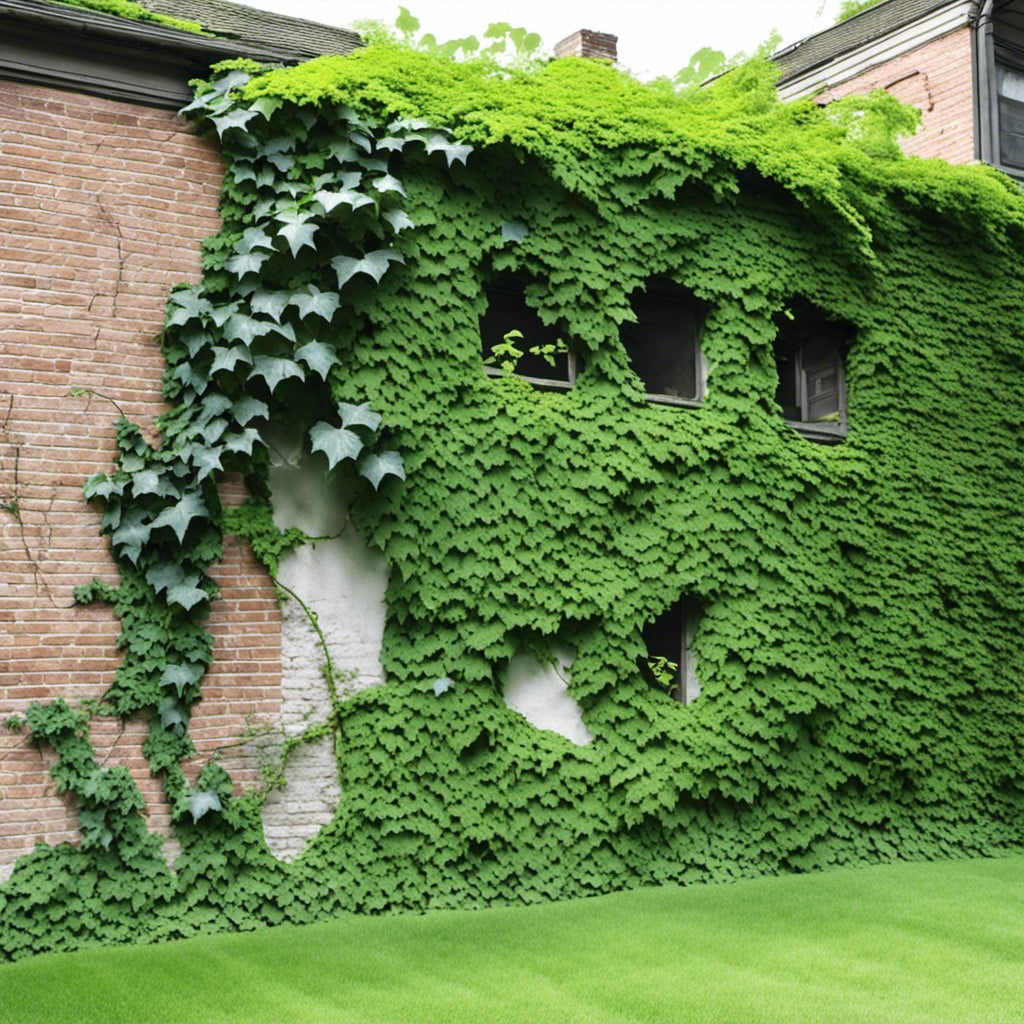
Caution should be exercised when it comes to placement; don’t plant the ivy too close to the house foundation to avoid potential damage. It’s essential to regularly trim and maintain your ivy to check aggressive growth that may harm other plants or even house structures.
Don’t forget the type of ivy you choose has great importance. Some species, like English Ivy, are invasive and can overwhelm your garden or aggressively attach to walls, pulling paint and stucco off.
Overwatering is another common mistake. Ivy needs well-drained soil, so excessive water can lead to root rot and other diseases.
Remember, without a supporting structure like a trellis or wire grid, ivy can fail to grow vertically. Always ensure proper support before you start the growing process.
Lastly, never underestimate the potential of ivy to attract pests. Regular monitoring for tell-tale signs of infestation can keep your ivy wall healthy and vibrant.
Combining Ivy Walls With Other Home Plants
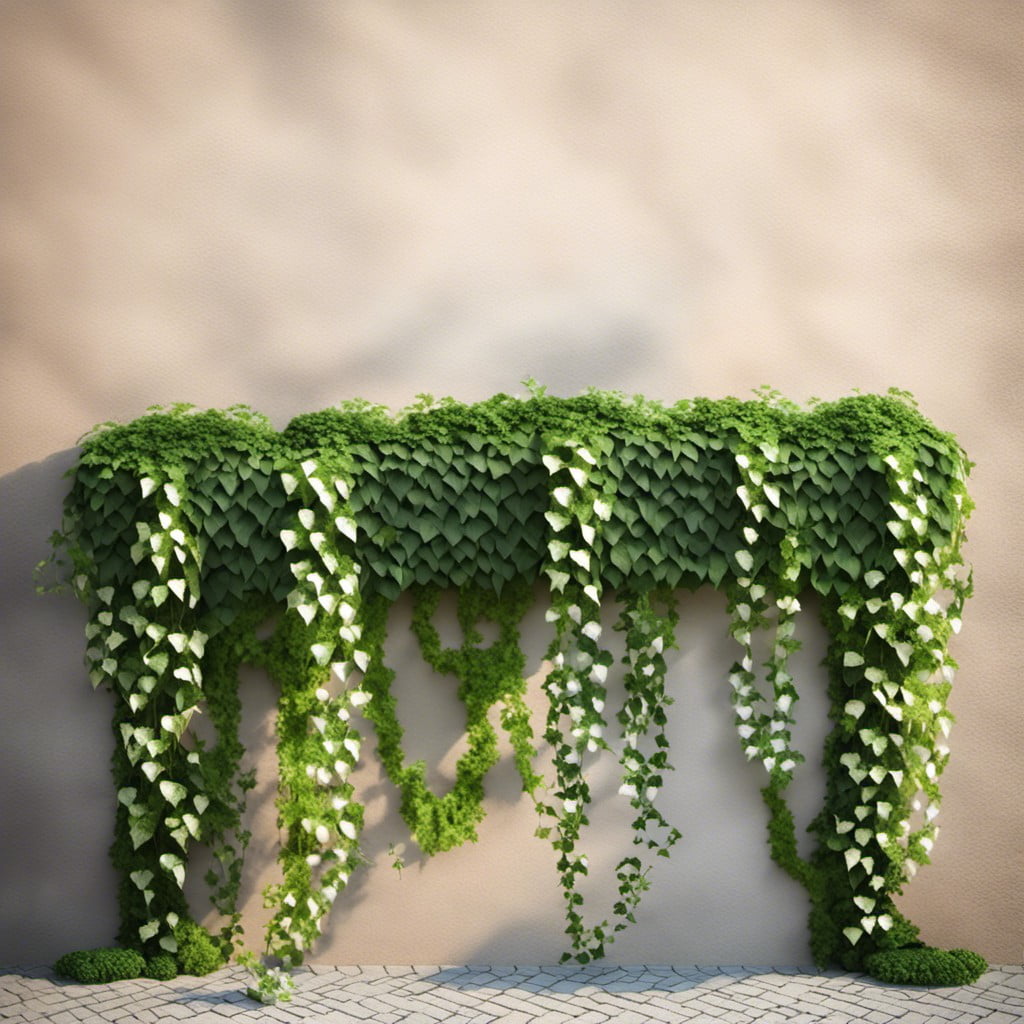
When blending ivy walls with other home plants, the foremost consideration is the need for similar climatic conditions. Here are some elements to contemplate:
1. Light Requirements: Both ivy and accompanying houseplants must thrive under similar lighting. For instance, ferns and snake plants do well in low to medium light, like most ivy species.
2. Watering Schedule: Over watering or under watering can hinder plant growth. Ensure you pair ivy with plants that demand a compatible watering routine.
3. Complementary Themes: Pair ivy walls with other plants that enhance each other visually. A Swiss cheese plant or a rubber tree complements the lush green of ivy excellently.
4. Size and Growth Patterns: Balance is vital. Avoid overshadowing the ivy wall with oversized, fast-growing plants. Calathea and peace lilies are perfect mates when considering growth rate and size.
5. Pest Resistance: Maintaining a group of plants with the same pest resistance is helpful in preventing and mitigating infestations.
Remember, the goal is to create an indoor green oasis that thrives harmoniously in your specific living conditions.
Ivy Wall for Balconies: A Green Space Solution
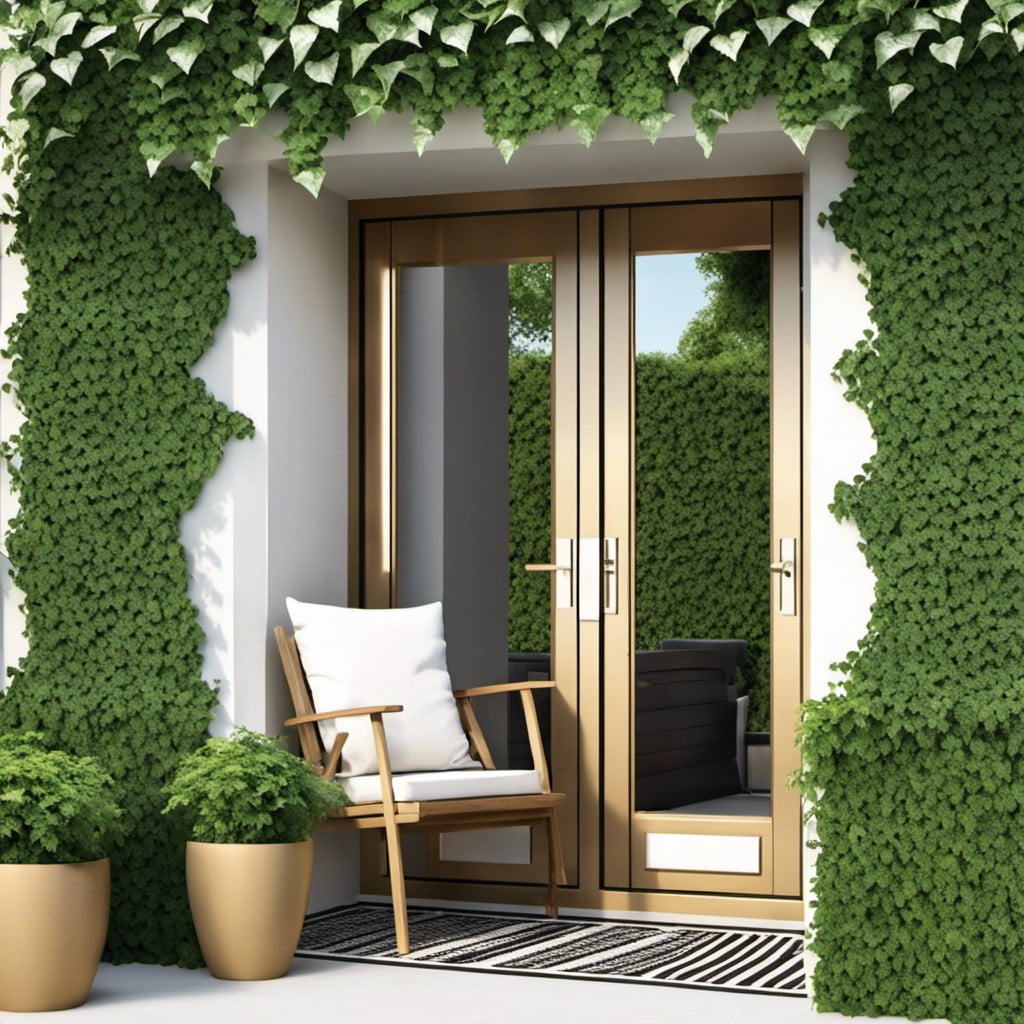
Even in the tiniest of urban apartments, balconies present an excellent opportunity to introduce some greenery and bring a bit of nature. Think of your balcony as an extension of your living space – enhance it with a green wall.
1. Use Vertical Space: Most balconies aren’t large, but remember, space is multidimensional. Plant your ivy at the base and allow it to climb using trellises or cages.
2. Choose the Right Ivy: Some species are better suited for outdoor environments. English Ivy and Boston Ivy are resilient to temperature changes and can grow well in contained regions.
3. Plan for Sunlight: Consider the direction and amount of sunlight your balcony receives daily. Ivy generally enjoys partial shade, but some species can withstand direct sun.
4. Regular Maintenance: Walls need pruning and watering. The plant’s growth can be aggressive, so regular trimmings will keep it in check. Water moderately to avoid waterlogging.
5. Add Fixtures: Install hooks, frames, or netting on the wall that ivy can grasp onto. Ensure these are securely attached as ivy can be weighty when fully mature.
6. Balcony Furniture: Consider furniture that complements your green balcony. Wooden or stone pieces can enhance the natural setting.
By implementing these points, you can transform your balcony into a serene green oasis, bringing outdoor freshness into your urban habitat.
Creating a Lush Jungle Vibe With Ivy Walls
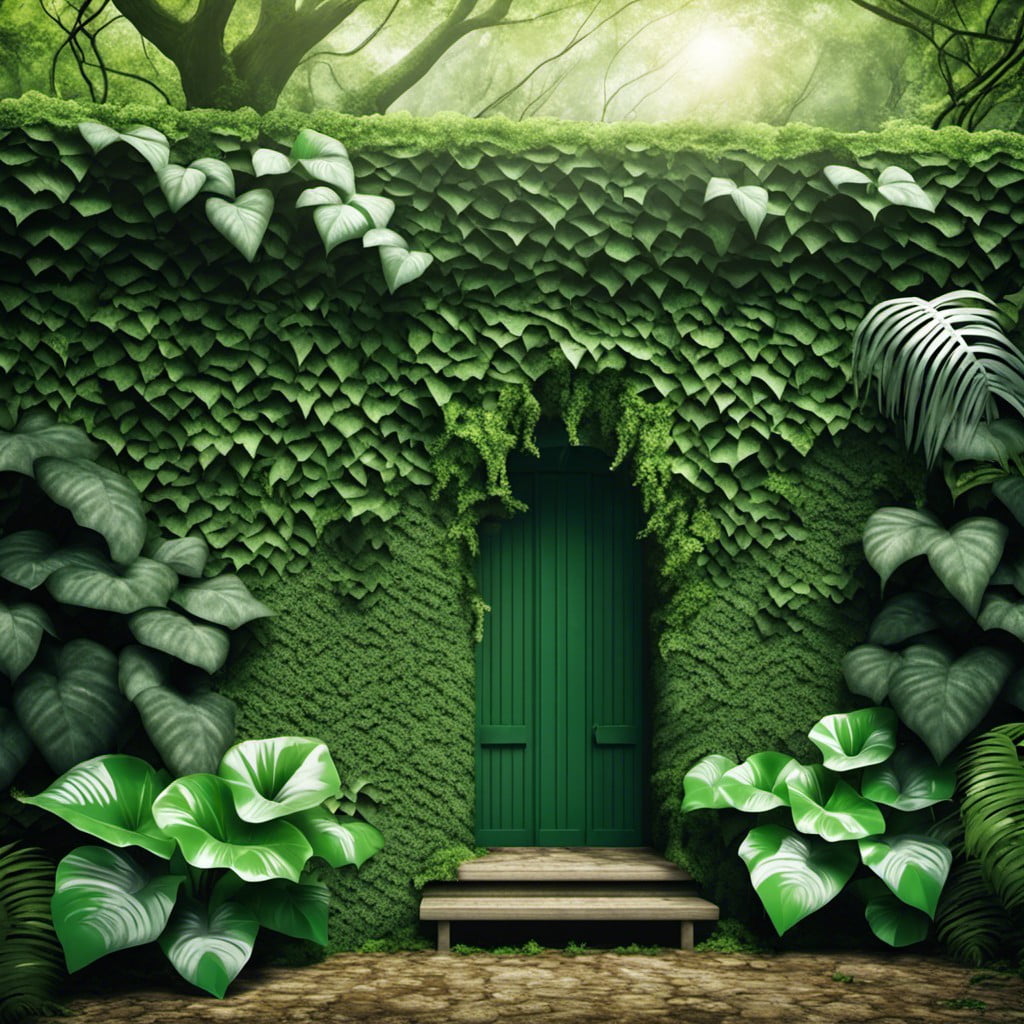
To evoke a jungle vibe, prioritize the use of different ivy species. This can bring in a sense of abundant, unstructured growth akin to a tropical forest. Layer thick ivy species like Persian Ivy with thinner ones such as English Ivy for texture and depth.
Ensure you cater to each plant’s specific needs, as they might differ in terms of sunlight or temperature.
To amplify the wild effect, drape some of the vines downwards. The cascading leaves can contribute an immersive, jungle-like feel.
Intersperse your ivy with other foliage. Ferns and palms add a further layer of diversity and thickness to your wall, serving as the perfect complement to the intertwining ivy.
Select pots and planters with natural materials like terracotta or wicker. This might provide an earthy undertone, reminiscent of a wild, untamed environment, completing the overall aesthetic of your indoor jungle.
Remember, it’s not solely about looking wild. Try incorporating the sounds of nature through a soundtrack or a small indoor water feature. This will boost the feeling of being in a lush, quiet jungle even further.
The Role of Ivy Walls in Interior Design
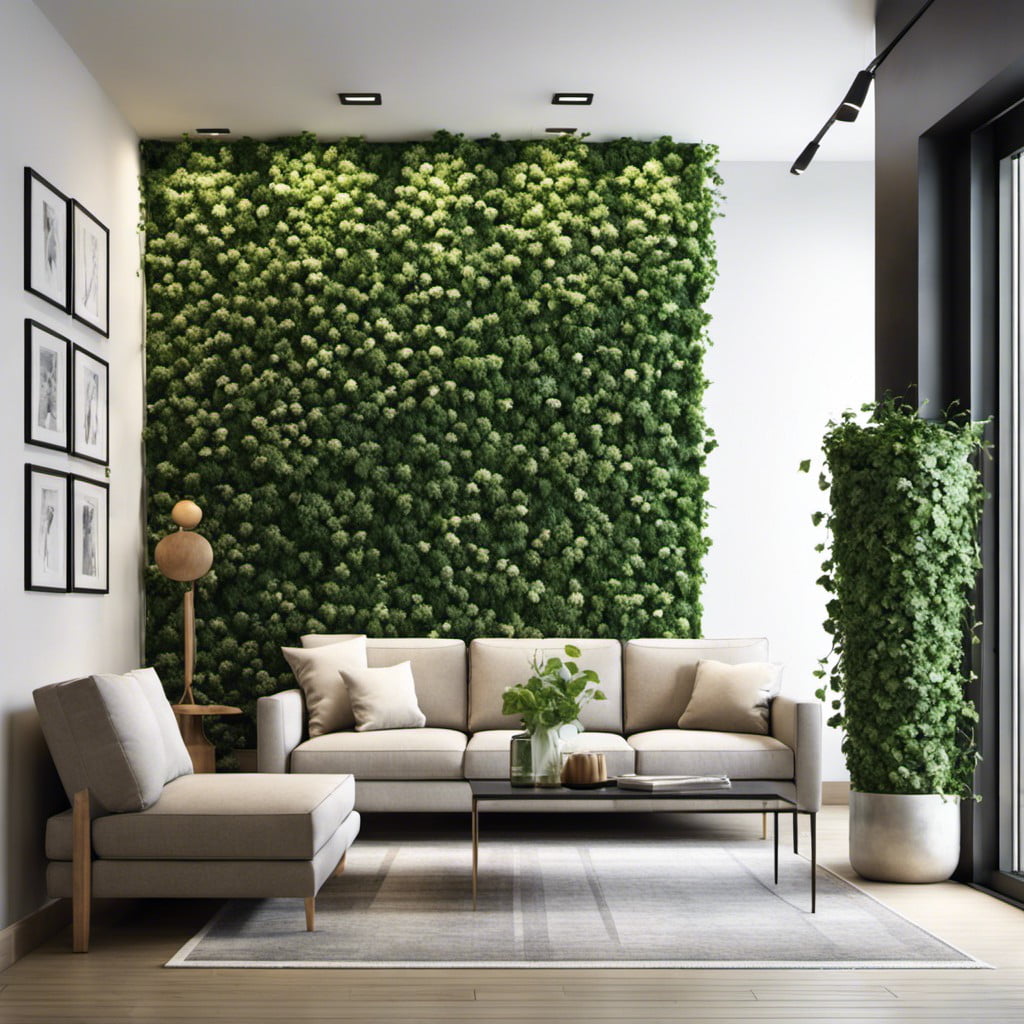
Ivy walls, when positioned correctly, serve as fascinating focal points that add depth to a room. Their unique texture provides an instant eye-catcher, introducing an element of the outdoors into urban living environments. What’s more, their lush greenery helps to soften hard architectural lines and can break up large, blank wall areas, giving a sense of coziness and warmth.
However, it’s essential to consider the overall aesthetic of your room before installing an ivy wall. For modern design schemes, keep an ivy’s growth pattern well-manicured to ensure a clean, geometric look. In contrast, a more boho or eclectic design might welcome a wilder, more organic growth pattern.
Don’t be afraid to get creative with the placement of your ivy wall either. It can work just as well as a feature behind a bed in a bedroom as it can as a statement wall in a living room.
Lastly, remember that vegetation like ivy can also help to improve air quality in your home, serving function and form in one! Combining such benefits with their visual appeal, ivy walls can really help bring a room to life.
Wall Paint Colors That Complement Ivy Walls
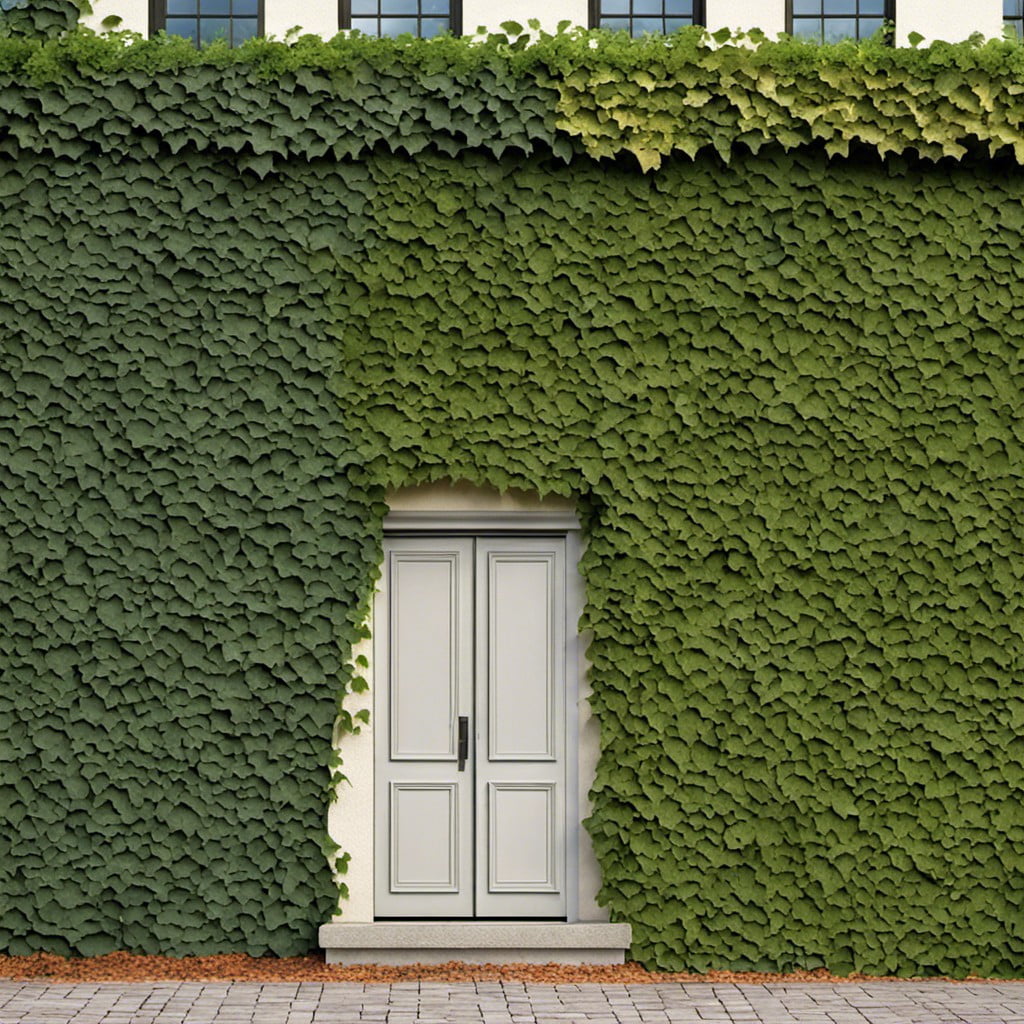
When selecting paint colors for walls adorned with ivy, greens often come to mind first. However, a variety of other tones can also expertly showcase the plant’s lush vibrancy.
1. Cream and Beige: These neutral hues can beautifully accentuate the natural tones of the ivy.
2. Pale Yellows: This choice can mimic sunlight, offering a warm backdrop for your green wall.
3. Blues and Purples: These cool shades can artistically contrast the ivy’s green hues, lending a more creative look to a room.
4. Smoky Grays: Use subtly for a modern and chic ambiance that intensifies the green richness of the ivy.
5. Brick Reds and Browns: Ideal for an old-world or rustic charm, these deep tones can underscore the earthy connection.
Remember, the goal is to find a color that will complement the ivy, enhancing its presence and making it a focal point in the room. Always consider how much light the room gets and remember to consider your furniture when determining the perfect shade.
Enhancing Workspaces With Ivy Walls
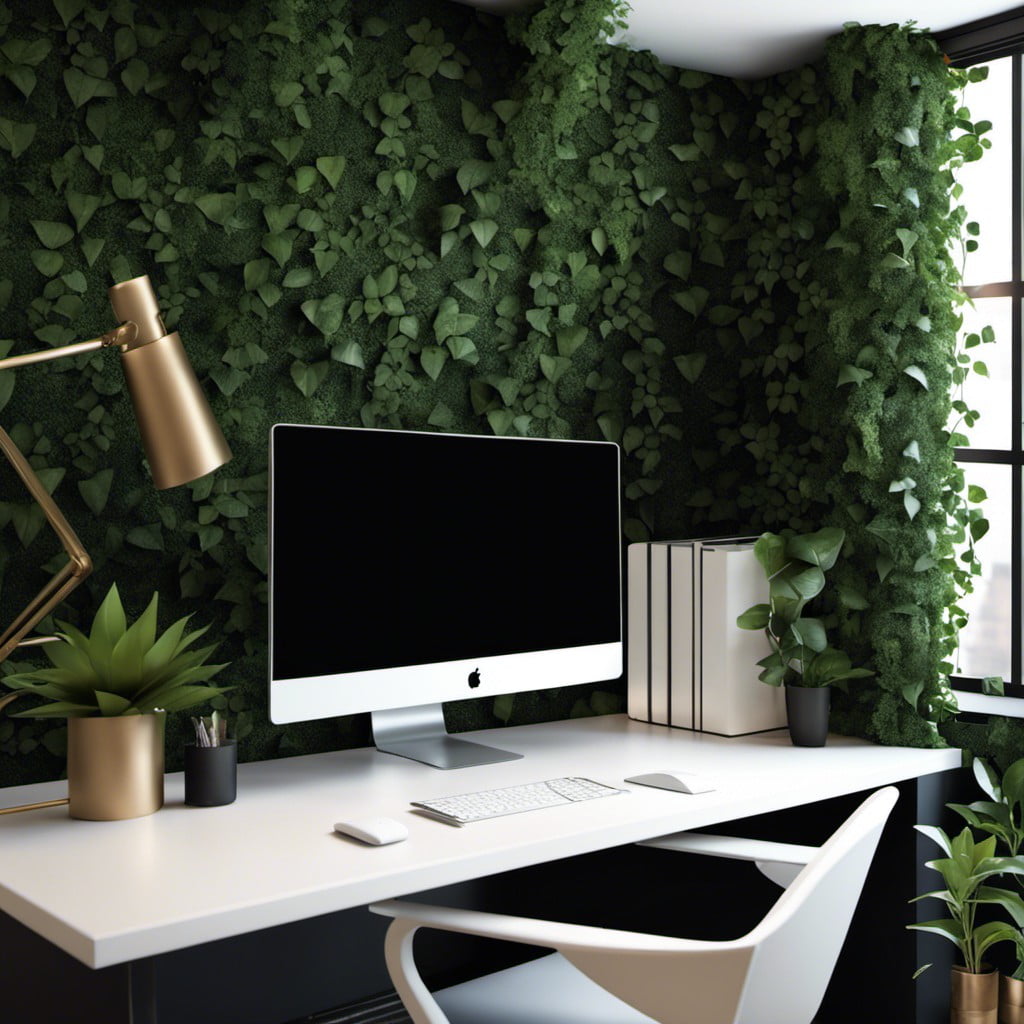
A well-placed ivy wall can do wonders for your workspace, adding a touch of nature that uplifts the overall ambiance. For open offices, an ivy wall divider not only creates a partition but inspires a refreshing feel.
Consider these points to beautifully incorporate ivy walls into your workspace:
- Placement is crucial: Locate your ivy wall where it will not block natural light. Adjacent to a window is a great choice.
- Proportion matters: An ivy wall shouldn’t overwhelm the space. Strike a balance in terms of the area it covers.
- Match its style: Ivy should complement the workspace decor. For a modern office, consider a geometric trellis. A vintage decor can handle more sprawling patterns.
- Maintenance is key: Ensure the ivy is well-maintained. Water it regularly and prune to maintain an attractive shape.
Remember, a little green can go a long way in giving your office a calming and rejuvenating energy. So why wait? Get started on enhancing your workspace with an ivy wall today.
Ideas Elsewhere
- https://averageinspired.com/2023/02/diy-ivy-wall-decor-with-lights.html
- https://www.intheknow.com/post/tiktok-ivy-wall-decor/
Recap:
